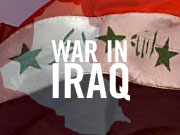Audio
Photos
Resources
| |||||||||||||||||||
 |
| Steve Mumford spent 10 month in Baghdad as a war artist, sketching and painting the conflict he saw on the streets. (Image courtesy of Steve Mumford) |
Minneapolis, Minn. — Steve Mumford made it clear to his Humphrey Institute audience that he went to Iraq not for journalistic reasons, but artistic ones. His role model was Winslow Homer, a 19th century American painter who worked for Harper's Weekly during the Civil War as a combat artist.
"I loved that work," Mumford says. "And when this war started, it occurred to me I could try to do something similar."
Mumford requested to be an embedded artist with the Army during the war, but was told there were no more openings. He decided to fly to Kuwait City, and languished in overpriced hotels, waiting for an opportunity to go in.
He ended up accompanying a team of French journalists to Baghdad, and at one point started to have panic attacks about being there. Mumford says he then took out his sketch pad and started drawing a street scene. He convinced himself he had as much right to be in Iraq as anyone.
"Over two years and four trips to Iraq, I often was revisited with these moments of extreme doubt over the legitimacy of my role," he says. "And I was always was able to kind of assuage them by actually doing what I went there to do, which was to draw."
Mumford eventually started taking digital pictures of his work, and sent back the images and blog-like descriptions of his experiences to a Web site, artnet.com. His writing, sketches, drawings and watercolors are captured in his new book, "Baghdad Journal: An Artist in Occupied Iraq."
There are depictions of soldiers in Humvees on patrol, standing guard, or watching war movies in their free time. There are also renderings of Iraqi citizens, at the market, in tea houses, in jail cells, and talking to American soldiers.
One drawing shows an Army captain called Roig seated across a table from an Imam or religious leader, negotiating the release of an intellectual being held in Abu Ghraib prison. As Mumford recalls, the situation was extremely tense and heated words were exchanged.
"And then Roig said, 'Well you know, hopefully in five years we'll just be laughing about this.' And the Imam said, 'Hopefully in five years you guys will be long gone.'"
Mumford says he wanted to capture the clash of two distinctly different civilizations in the Iraqi desert. He concentrated not on major skirmishes, but on the daily interactions between American soldiers and Iraqis.
Mumford says that kind of focus ended up being more revealing than the typical coverage on the nightly news or in the morning papers.
"I think in a way that says more about what it's really like in Iraq, than the photographs of the one in 10 or one in 20 missions where a shot is fired. Because that's what the majority of the missions were like," Mumford says.
Mumford says he intially was opposed to the war because he felt it was reckless and naive, but believes the U.S. needs to stay and finish the job. He also admits to having a romantic view of war and the male bonding that occurs.
That's why University of Minnesota art professor Lynn Lukkas felt conflicted about Mumford's work.
"Because I think we've moved beyond Winslow Homer. Because I hope we've moved beyond a time when war and soldiering is thought of as a heroic and romantic adventure," Lukkas says.
Diane Mullin, associate curator at the Weisman Art Museum, agrees with Lukkas. Mullin says what's peculiar is how Mumford's romanticized notion of war, in her view, doesn't come through in his work.
"The pictures ... don't seem romantic. They don't seem full of passion. Very flat and very quiet and very disinterested in a certain way," says Mullin.
It's Steve Mumford's hope that if nothing else, his work will let young artists know they don't have to wait for permission to take their sketch pads to hot spots around the world.
His next project is draw and then paint wounded veterans in Walter Reed Medical Center in Bethesda, Maryland.








